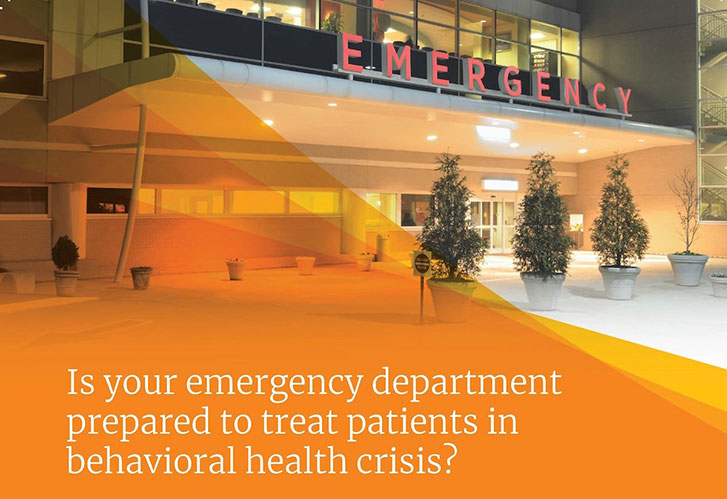Emergency department (ED) behavioral health patient volumes have increased at staggering rates in recent years. This is putting increased strain on patients, providers, and health systems, resulting in overcrowding, lost revenue, and patient dissatisfaction.
In April, Vituity brought healthcare leaders together at Becker’s Hospital Review 10th Annual Meeting to discuss the behavioral health crisis facing our nations EDs. Together they talked about contributing factors and innovative solutions.
Here are five highlights from the discussion:
#1 Care team integration is critical.
Providers believe improving care is their #1 obligation. Frontline providers feel intense pressure to treat patients across a wide variety of conditions, and recognize that patients experiencing acute psychiatric emergencies often fall through the cracks of our existing system. An integrated care team is critical to filling the gaps.
“The most successfully run EDs are the ones with well-coordinated interdisciplinary teams – nursing leaders, physician leaders, radiology, pharmacy, behavioral health specialists, and more – that ensure a safe and effective healing environment and a customized care plan for each patient.” – Matt Stilson, MD, FACEP, Executive Vice President, Emergency Medicine, Vituity
#2 Executive discipline and physician leadership is imperative to create cultural change.
Patient overcrowding and lack of staff to handle behavioral health patients increase provider stress levels in the ED, causing burnout. Hospital administrators and physician leaders need to partner in order to ensure care team accountability and unified priorities. Across care teams, everyone works hard to do the right thing for the patient, but often with conflicting priorities which ultimately hurts the culture and environment of the ED. These culture and process change initiatives need C-suite champions and support.
“Physician fatigue and burnout are real, we need to focus on the highest priorities and bring that focus and discipline down to the frontline care teams.” – Matt Stilson, MD, FACEP
#3 Care delivery models must evolve to meet the needs of today’s patients.
Most hospitals use an outdated approach to behavioral healthcare in the ED that focuses heavily on finding inpatient care, when in fact a majority of psychiatric crises can be addressed within 24 hours. A patient-centric system requires we rethink traditional assumptions about how acute behavioral care is delivered. New, integrated care models and innovations create opportunities to improve care for this patient population.
“Care delivery needs to evolve radically in the next few years as we get into Population Health. Previously, it was relatively easy to use the disease model of illness to treat patients. Now we need to engage with the mental health problems and substance abuse issues for successful treatment at the earlier stages of care delivery.” – Gregory Teas, MD, Chief of Psychiatry, AMITA Health Behavioral Medicine
“There’s both the opportunity and the need to get innovative and creative. Telehealth is certainly a part of that, and so are screening tools that help better guide patients to local care. We have to figure out how we can help our patients access the right care at the right time, without always thinking that EDs are their only resort.” – Christopher R. Novak, MS, LCPC, Vice President and Chief Operating Officer, AMITA Health Behavioral Medicine
#4 Training and education is necessary to maintain a safe and effective care environment.
EDs have become the safety net for psychiatric care, and there is need for continued training and education for ED teams. Standard processes and approaches are designed to treat physical emergencies. Care teams need to be trained on best practices for treating acute psychiatric patients who often don’t respond well to the chaotic ED environment due to the noise, crowding, and stress. Education for frontline providers is essential to accurately identify conditions that require fast access to specialists and train on more appropriate medication and agitation management.
“Emergency medicine is defined by time. With the treatment of many conditions, such as psychiatric care, you need to get the right care to the patient as soon as possible.” – Imamu Tomlinson, MD, MBA, Chief Executive Officer, Vituity
#5 Multidisciplinary collaboration and integration can transform care delivery.
One way to create collaboration and integration is to bring together emergency medicine and behavioral health providers through a collaborative, mentoring approach that provides guidance, resources, and support for the ED care team, as well as access to behavioral health clinicians and resources such as telepsychiatry, crisis stabilization units, and inpatient psychiatry.
“Increased collaboration between care providers is essential to both understand and effectively treat all patients, with tailored solutions for differing conditions. Providers cannot take a one size fits all approach.” – Imamu Tomlinson, MD, MBA
Designed by physicians, Vituity’s Empath solution brings together emergency and behavioral healthcare providers, through a formalized educational program covering best practices and the latest advances in treatments for acute psychiatric care. To learn more, visit vituity.com/healthcare-services/psychiatry.
Originally published April 8, 2019.






















